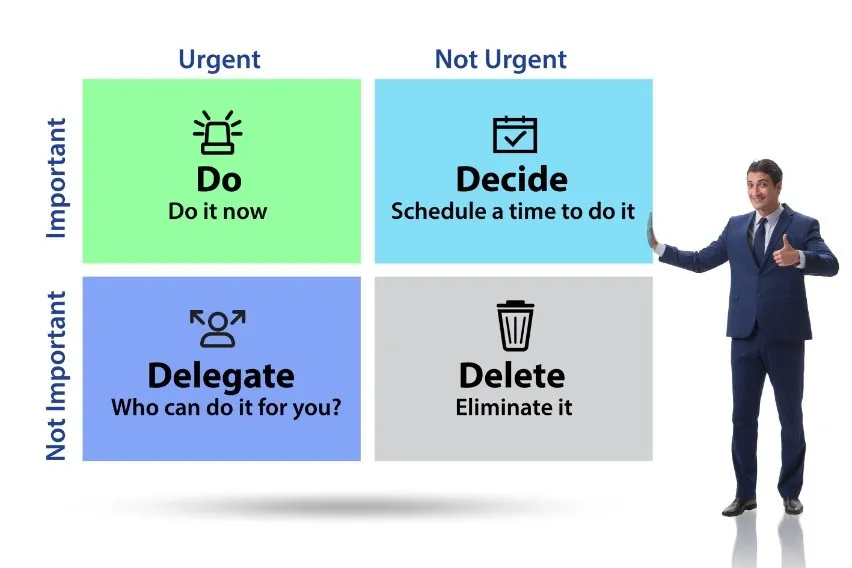Time Management Matrix: Definition, Importance & Benefits

Managing your time is tough. It may feel like you have dozens of things to do each day, which leads to stress. You feel overwhelmed by the sheer volume of things you’ve got to finish. And those negative feelings make it harder to figure out what to do first.
Creating a Time Management Matrix may be the solution.
This handy tool helps you organise your tasks based on their priority level. In turn, you get clarity on what you need to prioritise each day.
Table of Contents
What Is a Time Management Matrix?
Why Is a Time Matrix Important?
Benefits of Using the Time Management Matrix
Who Should Use a Time Management Matrix?
How to Create a Time Management Matrix
What Is a Time Management Matrix?
In 1989, American educator and businessman Stephen Covey released his book The 7 Habits of Highly Effective People. This book advised people on how to build habits that lead to success. It also had a section dedicated to managing your time.
In that section of the book, Covey introduced his Time Management Matrix. This productivity tool is designed to help people prioritise their task lists based on 4 metrics:
- Urgent
- Important
- Not Urgent
- Not Important
Using these metrics, the reader creates a matrix they can use to determine which categories their tasks fall into. Those classed as both urgent and important go to the top of your to-do list. Tasks that aren’t urgent or important go to the bottom.
Why Is a Time Matrix Important?
A lack of proper prioritisation is often the reason behind poor time management. Imagine you have a task list that contains 20 items. However, you can’t tell which of those items is more important than the others. Plus, you have no deadlines assigned to any of the tasks.
Where do you start when working through that list?
The answer is almost impossible to find because you don’t know enough about the tasks. This leads you to start something non-urgent and unimportant. That leaves an urgent and important task waiting.
When you finally get to the task you should have prioritised, you may be too late. Even if you aren’t, you give yourself less time to complete the task.
The Covey Time Management Matrix helps you figure out what needs doing now versus what you can do later. Using it means you have a better handle on your time. Important tasks get done first, ensuring you’re less likely to miss deadlines.
Benefits of Using the Time Management Matrix
There are several advantages of using the Time Management Matrix to organise your work. Each makes you more productive, resulting in better decisions and a more balanced professional life. Benefits include:
You Understand the Importance of Different Tasks
The Time Management Matrix forces you to think about your to-do list. You’ll consider tasks that are most important versus those that aren’t. That ability is crucial if you’re struggling to pick a starting point. If you can prioritise your tasks based on importance, you can see which require the majority of your focus. You may also identify tasks that you can offload because they take too much time with little reward.
Understanding Urgency
When you can divide tasks into urgent and non-urgent categories, you’re able to prioritise them better. The Time Management Matrix helps you do that. It also prompts a greater understanding of what urgency is as it relates to what you do.
For example, checking emails may seem urgent because you’re worried about missing something important. But more often than not, it’s a distraction that pulls focus away from a task that has actual urgency.
Develop Self-Awareness
Analysing yourself and your habits helps you to manage your time. With the Time Management Matrix, you get to see how you arrange your tasks. Do you tend to work on the easiest tasks first? Are you losing time to distractions?
The Time Management Matrix helps you answer these questions, leading to increased self-awareness. Then it becomes easier to spot the issues that cause time loss. The result is an increase in personal productivity.
Better Decision-Making
With repeated practice, you become better at identifying important and urgent tasks. As a result, your decision-making improves.
You no longer need to spend as much time determining which tasks should take priority. Instead, you can look at your task list and figure out what you need to do first in a matter of minutes. That faster decision-making pays off. It saves time, leaving you more room to play with.
Who Should Use a Time Management Matrix?
Anybody who feels overwhelmed by their work should use the Time Management Matrix. People who have to complete a lot of small tasks during their work days should also use one. Examples of people who can use the matrix include:
- CEOs who have to figure out how to split their time between meetings and other work.
- Project managers who are responsible for managing people, deadlines, and their own work.
- Administrative workers who may have dozens of small tasks to complete in a day.
- Sales professionals who have to prioritise their calls and the associated paperwork.
If you work in a fast-paced environment, the Time Management Matrix is a useful tool to master.
How to Create a Time Management Matrix
Thankfully, the Time Management Matrix is a simple tool designed for speedy use. Start by creating a two-by-two grid, with each cell being large enough to enter several tasks. Next, write the following words outside the grid:
- Urgent (Above the top-left cell)
- Not Urgent (Above the top-right cell)
- Important (To the left of the top-left cell)
- Not Important (To the left of the bottom-left cell)
With your grid created, you should see four quadrants take form:
- Urgent, Important
- Important, Not Urgent
- Urgent, Not Important
- Not Urgent, Not Important
These are the categories you enter your tasks into. Next, grab your task list and organise each item on it while following the below rules. Below is an example of the quadrants in a grid:

Urgent, Important
Anything that requires immediate attention goes into this category.
For example, a copywriter might have to write an article for a client by the end of the day. That’s an urgent task because of the deadline. It’s also important because missing the deadline angers the client, which could lead to lost business.
Generally speaking, if it’s a task you have to do right now, it goes into this category.
Important, Not Urgent
This category covers things you have to do that have no defined timescale. Creating a long-term business plan is a good example. The plan is important, but you may have several months to complete it, making it non-urgent.
Other tasks in this category may relate to your personal life, such as exercising. Exercising is good for your health, which makes it important. But you can never “complete” exercise, meaning it’s a long-term and non-urgent task.
Urgent, Not Important
This category tends to cover the little things you have to do that seem like a waste of your time.
If you’re a CEO, examples may include scheduling meetings, booking flights, and answering emails. Many of these are time-sensitive tasks. But doing them takes time away from the important tasks you need to focus on.
Anything that enters this category is often something you can delegate to other people.
Not Urgent, Not Important
The final category covers all your “time sinks”. These are the tasks that contribute nothing to your work.
Spending time on social media may fall into this category. Same goes for sorting through your email junk folder. These aren’t important tasks, and there’s no reason for you to do them. So, either delete them from your list or schedule them for a time when they won’t affect other work.
Key Takeaways
The Time Management Matrix helps you to develop proper time management skills. Using it helps you categorise tasks based on their importance and urgency. In doing so, you’re forced to stop focusing on non-urgent items.
Separate tasks on your Time Management Matrix into four categories. These include “Urgent, Important”, “Important, Not Urgent”, “Urgent, Not Important”, and “Not Urgent, Not Important”. Doing so will help you determine which tasks are crucial versus those that are not.
Managing time helps you achieve long-term goals and is key to your personal development.
FAQs on the Time Management Matrix
How does a Time Management Matrix improve productivity?
The Time Management Matrix improves productivity because it helps you see which tasks you need to complete. It also allows you to see what work you can offload and where you’re wasting time during your day. Finally, prioritising tasks helps you create a better work-life balance.
What causes poor time management?
Poor time management stems from several issues. These include a lack of clear goals and the inability to schedule your time properly. You may also have poor time management if you get distracted by common time wasters, like social media.
What is a common time management mistake?
Miscalculating the time and energy a task requires is one of the most common time management mistakes. This behaviour is typical in overachievers, who believe they can breeze through any task.
Experience leads to a better understanding of your tasks, making you less likely to make this mistake.
RELATED ARTICLES



 Materiality Concept in Accounting: Definition, Importance & Example
Materiality Concept in Accounting: Definition, Importance & Example Top-Down Estimating: Definition, Methods, Pros & Cons
Top-Down Estimating: Definition, Methods, Pros & Cons What is Fixed Expense & Variable Expense?
What is Fixed Expense & Variable Expense? What is Accrued Expense? Importance, Pros & Cons
What is Accrued Expense? Importance, Pros & Cons Project Cost Estimating: Definition, Importance & Methods
Project Cost Estimating: Definition, Importance & Methods